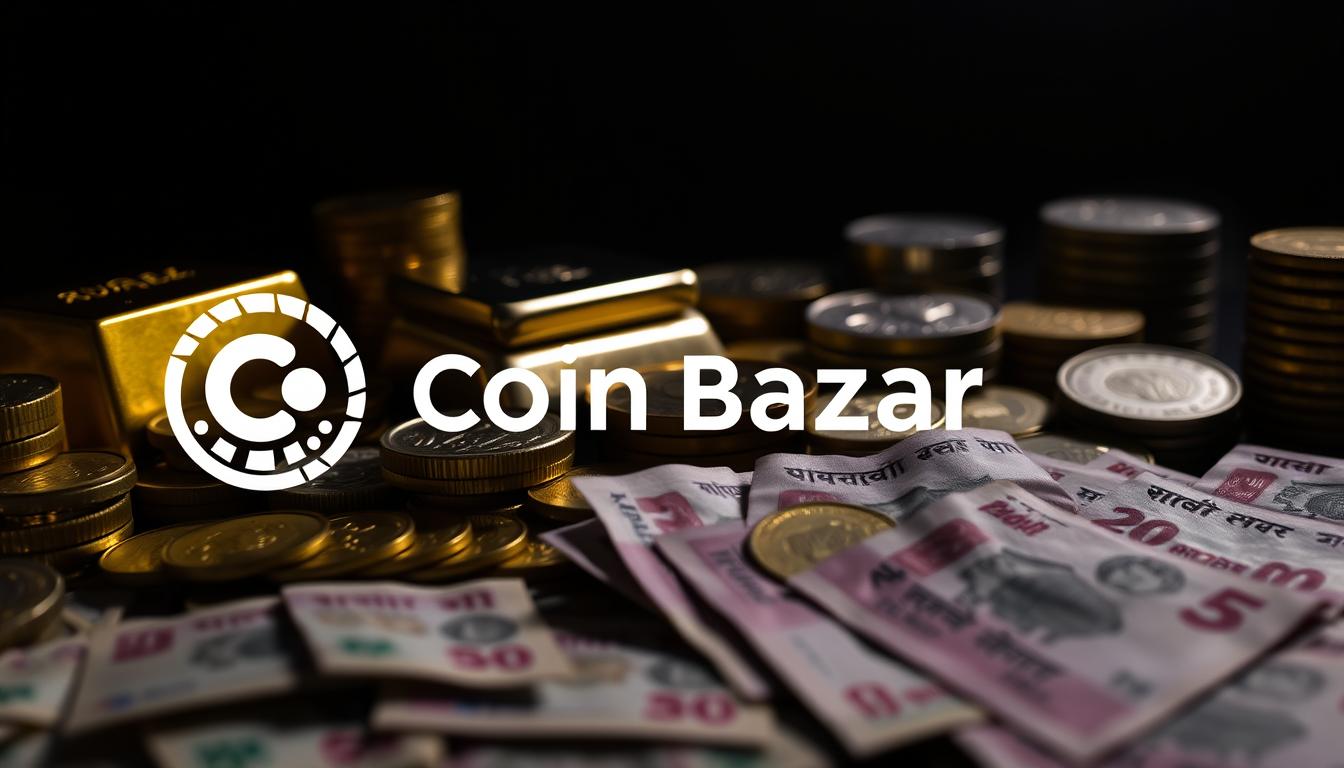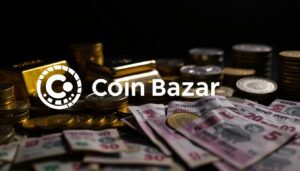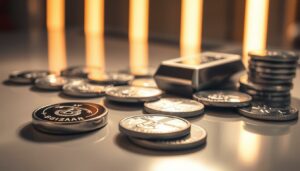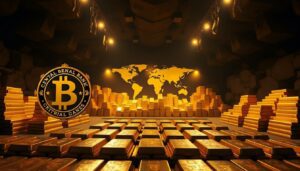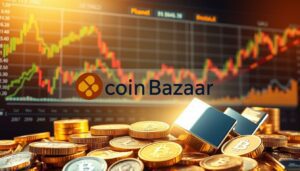Thinking about investing in precious metals? It’s key to know what’s happening in the market. The value of gold and other precious metals is greatly affected by the US dollar (USD) and interest rates. J.P. Morgan Research says gold prices could hit $3,675/oz by the fourth quarter of 2025. They predict prices will reach $4,000 by mid-2026.
This forecast shows how important precious metals are for investors. The USD and interest rates are key in the precious metals market. It’s vital for investors to keep up with these changes.
Key Takeaways
- The value of precious metals is closely tied to USD fluctuations and interest rate changes.
- Investors are advised to monitor economic forecasts and market trends.
- Gold prices are projected to rise significantly by 2025 and 2026.
- Diversifying your portfolio with precious metals can be a strategic move.
- Staying updated with market research and analysis is crucial for making informed investment decisions.
The Current State of Precious Metals Market in 2025
In 2025, the precious metals market is changing fast. Gold, silver, platinum, and palladium prices are affected by many things. Gold prices have hit new highs, partly because of President Trump’s tariff plans. This shows how the market is doing now.
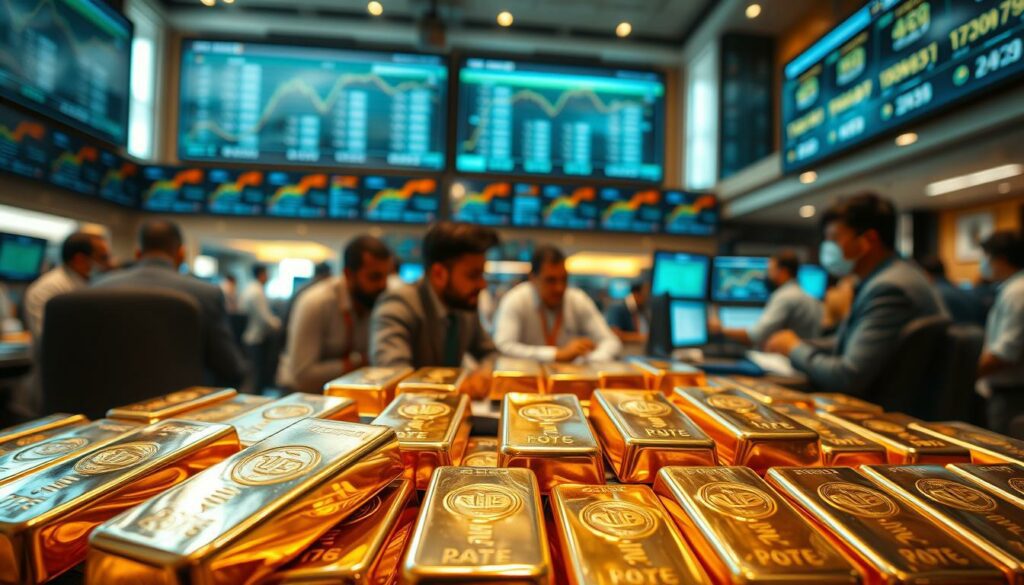

Market Overview and Recent Price Movements
The precious metals market has seen big price changes in 2025. Gold prices have gone up a lot. Central banks and investors keep wanting more gold.
Gold’s demand is about 710 tonnes every quarter this year. This shows people still see gold as a safe place to put their money.
But gold isn’t the only one moving. Silver and platinum prices have changed too. This is because of different economic factors.
Key Economic Factors Driving the Market
Several economic factors are shaping the precious metals market in 2025. The strength of the USD and changes in interest rates matter a lot. When the USD gets stronger, gold becomes pricier for foreign buyers. But if the USD weakens, gold prices might go up.
Interest rates also affect the market. Lower rates make gold more appealing because it doesn’t earn interest. This makes gold more attractive to investors.
Understanding the Relationship Between USD and Precious Metals
The strength of the US dollar affects precious metal prices. When the dollar is strong, these metals tend to be more expensive. This is important for investors to know, as it can change the value of their investments.
The Inverse Correlation Explained
A weaker dollar makes precious metals cheaper for foreign investors. This increases demand and drives up prices. On the other hand, a strong USD can make these metals more expensive, which might lower demand and prices.
Why Precious Metals Rise When USD Falls
When the USD falls, precious metals prices tend to rise. This is because foreign investors find these commodities cheaper. As a financial expert noted, “A weaker dollar is often accompanied by higher gold prices, as investors seek safe-haven assets.”
Historical Examples and Patterns
There have been times when the USD’s weakness led to higher gold prices. For example, in the early 2000s, when the USD fell against major currencies, gold prices soared.
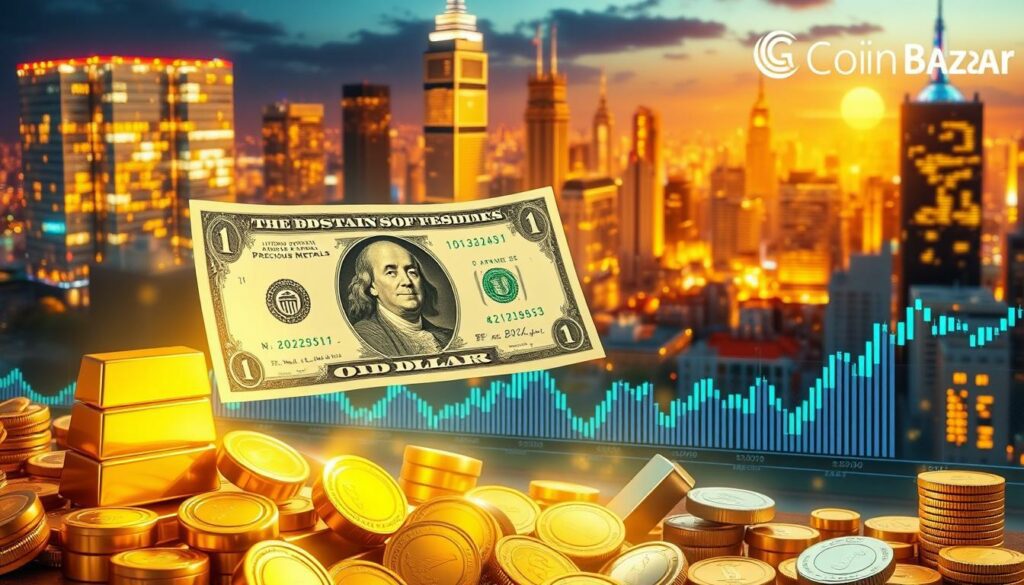

Current USD Strength and Its Impact on Metal Prices
Today, a strong USD affects precious metal prices. It makes gold and silver more expensive for foreign investors. Yet, other factors like interest rates and inflation also play a role. As a market analyst said, “The relationship between the USD and precious metals is complex and influenced by multiple factors.”
It’s crucial for investors to understand these dynamics. By watching USD changes and their effect on metal prices, investors can make better choices.
How Interest Rate Fluctuations Impact Precious Metals
The link between interest rates and precious metals is complex. Knowing this can guide your investment choices. Central banks, like the Federal Reserve in the U.S., set interest rates. These rates change the borrowing costs, affecting how attractive precious metals are as investments.
The Mechanism Behind Interest Rates and Metal Prices
When interest rates go up, it costs more to hold gold and silver. This is because bonds or savings accounts offer better returns. So, investors might sell precious metals to get into these higher-yielding options, lowering their prices.
Opportunity Cost Theory
The opportunity cost theory explains that high interest rates make precious metals less appealing. This is because they don’t earn interest. But, when rates are low, the opposite happens, and demand for precious metals might rise.
Borrowing Costs for Mining Companies
Higher interest rates also raise borrowing costs for mining companies. This can cut into their profits and affect the supply of precious metals. Such changes can push up metal prices, as production costs increase.
Federal Reserve Policies and Global Implications
The Federal Reserve’s interest rate policies affect the world, influencing currency values and investment flows. A shift in U.S. interest rates can make the dollar stronger or weaker. This, in turn, impacts precious metal prices, as they’re often priced in dollars. It’s key for investors to understand these connections to navigate the precious metals market well.
By staying updated on interest rate changes and their effects on precious metals, you can make better investment choices in this market.
Gold Performance in 2025: USD and Interest Rate Effects
In 2025, gold’s performance is greatly affected by the USD and interest rates. Investors are watching these closely to decide on precious metals. This helps them make smart investment choices.
Current Gold Pricing Trends and Forecasts
J.P. Morgan Research predicts gold prices will average $3,675/oz by the fourth quarter of 2025. This is due to high demand from central banks and investors. Central banks are expected to buy 900 tonnes of gold in 2025, showing their trust in gold.
Gold prices look good, thanks to its opposite relationship with the USD. When the USD weakens, gold prices go up. This is key for investors to know when dealing with currency and precious metals.
Key factors influencing gold prices include:
- USD strength and its impact on gold’s attractiveness
- Interest rate policies and their effect on opportunity costs
- Global economic conditions and geopolitical tensions
Investment Outlook for Gold in the Indian Market
The Indian market is a great place for gold investment, with many options. Gold investment in India is looking up, thanks to cultural love for gold and its safe-haven status.
Gold ETFs vs. Physical Gold in India
In India, investors can pick between Gold ETFs and physical gold. Gold ETFs are easy and cheap, letting you invest in gold without storage worries. Physical gold, however, is still popular for its real value and cultural importance.
Sovereign Gold Bonds Performance
Sovereign Gold Bonds (SGBs) in India are a hit, offering a safe and profitable way to invest in gold. SGBs give a fixed return plus the chance for gold price gains. They’re great for those wanting safety and returns in their portfolios.
SGBs have done well, mirroring gold prices but with interest income. This makes them a solid choice for diversifying with precious metals.
Silver Market Dynamics Under Currency and Rate Pressures
Silver is a precious metal with many uses. Its value changes with the US dollar and interest rates. This affects both its industrial uses and its appeal as an investment.
Industrial Demand vs. Investment Appeal
Silver has two main uses: in industries and as an investment. It’s key in electronics and renewable energy. It’s also seen as a safe choice against inflation and currency drops, drawing in investors.
Industrial demand for silver is growing with new tech. But, its appeal as an investment can change with currency and interest rates.
Silver’s Position in the Indian Investment Landscape
In India, silver is more than just an investment. It holds cultural value, used in jewelry and coins. Knowing the differences between these investments is key for investors.
Silver Jewelry vs. Silver Coins and Bars
Silver jewelry is bought for its beauty, while coins and bars are for investment. Jewelry’s making costs can be high, impacting resale value. Coins and bars are bought at a premium over silver’s spot price.
Tax Implications for Silver Investments
Investing in silver comes with tax considerations. In India, capital gains tax applies to silver profits. The tax rate depends on the profit’s duration.
| Investment Form | Characteristics | Tax Implications |
|---|---|---|
| Silver Jewelry | Aesthetic value, high making charges | Capital Gains Tax |
| Silver Coins and Bars | Purchased at a premium, investment purpose | Capital Gains Tax |
Platinum and Palladium: Industrial Metals in a Changing Economy
The global economy is always changing, and platinum and palladium are key players. As an investor, it’s important to know how these metals work. They play a big role in the automotive industry.
Automotive Industry Influence on Platinum Group Metals
The car industry drives demand for platinum and palladium. They are used in catalytic converters to cut down harmful emissions. These metals are crucial for making vehicles cleaner.
As car makers aim for cleaner cars, the need for these metals will change.
Investment Potential for Indian Investors
Indian investors can diversify with platinum and palladium. You can invest in these metals in many ways, like ETFs, mutual funds, or owning them physically. Knowing the market and price factors is key for smart investing.
Availability Challenges in the Indian Market
Indian investors face a big challenge: finding platinum and palladium. The supply chain is complex, making it hard to find reliable sources. It’s vital to buy from trusted sellers to avoid fake products.
Import Regulations and Considerations
Import rules also affect platinum and palladium in India. You need to keep up with current rules and any changes. Following these rules is important for smooth transactions.
The Benefits of Precious Metals as Portfolio Diversifiers
Precious metals are great for making your portfolio more diverse. They help reduce risk and can increase returns. Their low connection to other investments makes them a smart choice.
Correlation with Other Asset Classes
Precious metals don’t move with stocks and bonds as much. This means they can help when other investments are down. For example, when the economy is shaky, gold often goes up while stocks fall.
“Adding precious metals to your portfolio can protect against market drops,” says a top financial expert. “They don’t follow the stock market’s ups and downs, making them key for a balanced investment plan.”
Optimal Allocation Percentages for Indian Investors
How much to invest in precious metals depends on your age, risk level, and goals. Experts suggest 5% to 15% of your portfolio for precious metals. But, it really depends on your personal situation.
Age-Based Allocation Strategies
Younger investors might start with a smaller share of precious metals. They have more time to take risks. Older investors, close to retirement, might want more precious metals to keep their money safe.
Risk Tolerance Considerations
If you’re risk-averse, you might want more precious metals. It’s key to know your risk level and financial aims when picking how much to invest in precious metals.
Adding precious metals to your portfolio can make it stronger and more varied. Whether you’re new to investing or have experience, including precious metals can help you reach your financial goals.
Central Bank Policies and Their Effect on Precious Metals
Understanding the role of central banks in the precious metals market is key. Their decisions on reserve diversification can greatly affect demand. This, in turn, influences the prices of precious metals.
Global Reserve Diversification Trends
Central banks worldwide are adding more gold to their reserves. This move aims to lessen reliance on one currency and protect against economic risks.The growing demand for gold from central banks has played a big role in its price changes. Remember, this trend isn’t just for gold; other precious metals are also seeing increased interest from central banks.
The Reserve Bank of India’s Gold Reserves Strategy
The Reserve Bank of India (RBI) is also boosting its gold reserves. The RBI’s gold holdings have been rising, showing its faith in gold as a safe investment. Expect the RBI to keep buying gold to diversify its reserves and guard against economic threats.
Knowing how central banks’ policies affect precious metals can help you make better investment choices. The ongoing trend of reserve diversification will likely keep supporting the demand for precious metals.
Inflation Concerns and Precious Metals as Hedging Tools
As inflation worries grow worldwide, investors are looking at precious metals as a safe choice. The economy is facing rising costs and uncertainty. It’s key for investors to protect their wealth.
Current Inflation Scenarios in India and Worldwide
Inflation rates are changing, worrying investors and shoppers. In India, inflation swings due to supply issues and money policies. Around the world, many countries are seeing high inflation.
Inflation affects more than just prices. It also impacts investment choices. As inflation goes up, money’s value drops. Investors need assets that keep or grow in value.
Effectiveness of Different Metals as Inflation Hedges
Precious metals like gold and silver are seen as good against inflation. Their value often goes up when inflation does. This makes them a favorite among investors.
Gold vs. Silver in Inflationary Environments
Gold is often viewed as a more stable value than silver. But silver has its benefits, like its use in industry. This can boost demand and price. Both metals can do well in inflation, but results vary.
Historical Performance During High Inflation Periods
Gold has done well in high inflation times. For example, in the 1970s, gold prices jumped with inflation. Silver also saw price hikes, but its performance was more up and down.
| Metal | Performance During High Inflation |
|---|---|
| Gold | Historically strong, often used as a hedge |
| Silver | Volatile, but generally increases in value |
In conclusion, precious metals are a solid choice for investors against inflation. Knowing their past performance and current trends helps investors make smart choices.
How to Buy Precious Metals in India: Options for 2025
As an Indian investor, you might wonder how to buy precious metals in 2025. There are many ways to invest, and knowing them can help you make smart choices.
Physical Ownership: Coins, Bars, and Jewelry
Many Indian investors choose to buy physical precious metals. You can pick coins, bars, or jewelry, each with its own benefits.
Reputable Dealers and Verification Methods
It’s important to buy from reputable dealers to avoid fake products. Look for dealers certified by the Bureau of Indian Standards (BIS) or the Indian Bullion and Jewellers Association (IBJA). Always check the product’s authenticity through hallmarking or other methods.
Storage and Insurance Considerations
After buying physical precious metals, think about storage and insurance costs. You might need to rent a safe or buy insurance to protect your investment from theft or loss.
Paper Investments: ETFs, Mutual Funds, and Digital Gold
If you don’t want physical metals, you can invest in paper products like Exchange-Traded Funds (ETFs), Mutual Funds, or Digital Gold. These options are flexible and might be cheaper.
Cost Comparison and Liquidity Factors
When picking paper investments, compare costs like management fees and expense ratios. Also, think about the liquidity of the investment, as some might be easier to sell than others.
Regulatory Protections for Investors
Paper investments have regulatory protections. For example, SEBI (Securities and Exchange Board of India) oversees ETFs and Mutual Funds, offering safety for investors. Know the rules that apply to your chosen investment.
By knowing the different ways to buy precious metals in India, you can make choices that fit your financial goals and risk level.
Digital Currencies vs. Precious Metals: Competing Safe Havens
The world of investing is changing fast. Now, digital currencies and precious metals are seen as safe places to put money. In India, people are looking for new ways to make their investments safer.
Changing Investor Preferences in India
For a long time, Indians loved investing in gold. But now, Bitcoin and other digital currencies are catching their eye. A recent survey shows many Indians are thinking about using digital currencies instead of gold.
More people know about digital currencies now. They like how easy it is to use them and how they can add variety to their investments.
“The future of safe-haven assets is likely to be a mix of traditional assets like gold and newer assets like digital currencies.” – Expert Opinion
Coexistence Possibilities in Investment Portfolios
Can digital currencies and precious metals work together in investments? Yes, they can. Each has its own special qualities. Gold is solid and valuable, while digital currencies offer a chance for big growth.
| Investment Characteristics | Precious Metals | Digital Currencies |
|---|---|---|
| Tangibility | Yes | No |
| Decentralization | No | Yes |
| Growth Potential | Moderate | High |
Having both digital currencies and precious metals in a portfolio can be smart. It balances risk and reward. This way, investors can enjoy the steady value of gold and the potential of digital currencies.
In summary, the battle between digital currencies and precious metals as safe investments will keep going. But, instead of seeing them as rivals, investors can mix them in their portfolios. This approach can lead to a well-rounded investment strategy.
Risk Assessment: Volatility Factors in the Precious Metals Market
When investing in precious metals, it’s important to consider geopolitical tensions, economic changes, and seasonal demand. These factors are key to understanding the precious metals market in 2025.
Geopolitical Influences on Metal Prices
Geopolitical events greatly affect precious metal prices. Conflicts, trade wars, and political instability boost demand for gold and silver. This demand increase can drive up their prices.
Key geopolitical factors to watch include:
- Elections and political changes in major economies
- Trade agreements and tariffs
- Conflicts and military interventions
Economic Uncertainty and Market Reactions
Economic uncertainty also plays a big role in the precious metals market. When the economy is shaky, investors often choose precious metals as a safe option. Market reactions to economic data like GDP and inflation can change metal prices.
Economic indicators to monitor include:
- Inflation rates and central bank policies
- GDP growth and employment figures
- Currency exchange rates and trade balances
Seasonal Patterns in Indian Precious Metals Demand
India is a big consumer of precious metals, especially gold. Demand can rise during festivals and wedding seasons, affecting global prices. Knowing these patterns can help with investment decisions.
Global Events Affecting Local Prices
Global events like economic sanctions, natural disasters, and health crises can impact local precious metals markets. Staying informed about these events can help you predict and adjust to market changes.
Future Projections: Precious Metals Outlook Through 2025-2026
The global economy is changing fast. Precious metals are becoming key for investment portfolios from 2025-2026. As the economy stays uncertain, people will look to precious metals as a safe choice.
Expert Forecasts and Analysis
Experts say precious metals demand will stay strong. This is due to central banks and investors wanting them. Many predict prices will either stay the same or go up by 2025-2026.
Key factors influencing this outlook include:
- Central bank buying trends
- Investor demand for safe-haven assets
- Global economic conditions
| Metal | 2025 Forecast | 2026 Forecast |
|---|---|---|
| Gold | Stable | Positive |
| Silver | Positive | Very Positive |
| Platinum | Stable | Positive |
Potential Disruptions and Opportunities for Indian Investors
Indian investors can grow their wealth by adding precious metals to their portfolios. Changes in central bank policies or global tensions could open new chances for smart investors.
Key opportunities for Indian investors include:
- Diversifying portfolios with precious metals
- Taking advantage of potential price fluctuations
- Investing in ETFs or mutual funds that track precious metals
Conclusion: Navigating Precious Metals Investments in a Dynamic Economic Environment
Understanding the factors that affect precious metals prices is key. The USD and interest rates are major players in the market. Keeping up with these can guide your investment choices.
Investing in precious metals means knowing the economic and market trends well. By staying informed, you can spot good opportunities and avoid risks. Whether you’re new or experienced, a smart approach to precious metals investing can boost your portfolio.
When investing in precious metals, a flexible and informed strategy is essential. Stay current with market trends and economic signs. This will help you maximize your precious metals investments.






